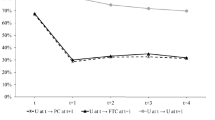Abstract
In this chapter, we analyse the routinization process in European countries, using the longitudinal component of the EU Survey on Income and Living Conditions (SILC). Our findings confirm that routine jobs and the routine intensity of jobs are decreasing in time. Further, we study the determinants of routinization, using the EU-SILC data, and find that young individuals are more likely to hold routine jobs, as are workers with lower education or those employed in temporary jobs. This evidence applies for overall Europe as well as for different groups of countries. Finally, routinization represents a driver of unemployment inflows: individuals in routine jobs display, ceteris paribus, a higher probability to become unemployed: a one standard deviation increase in the RTI index entails a 10% increase of getting into unemployment.
Access this chapter
Tax calculation will be finalised at checkout
Purchases are for personal use only
Similar content being viewed by others
References
Autor, David H., and David Dorn. 2013. “The Growth of Low-Skill Service Jobs and the Polarization of the US Labor Market.” American Economic Review 103 (5): 1553–1597.
Autor, David, Frank Levy, and Richard Murnane. 2003. “The Skill Content of Recent Technological Change: An Empirical Exploration.” The Quarterly Journal of Economics 118 (4): 1279–1333.
Autor, David, Lawrence Katz, and Melissa Kearney. 2006. “The Polarization of U.S. Labor Market.” American Economic Review 96 (2): 184–194.
Brynjolfsson, Erik, and Andrew McAfee. 2011. Race Against the Machine: How the Digital Revolution is Accelerating Innovation, Driving Productivity, and Irreversibly Transforming Employment and the Economy. Lexington, MA: Digital Frontier Press.
Brynjolfsson, Erik, and Andrew McAfee. 2014. The Second Machine Age: Work, Progress and Prosperity in a Time of Brilliant Technologies. New York: W. W. Norton.
Cortes, Mathias. 2016. “Where Have the Middle-Wage Workers Gone? A Study of Polarization Using Panel Data.” Journal Of Labour Economics 34 (1): 63–105.
Cortes, Mathias, Nir Jaimovich, Christopher Nekarda, and Henry Siu. 2016. The Micro and Macro of Disappearing Routine Jobs: A Flows Approach. New York: Mimeo.
Engel, Melissa, and Sandra Schaffner. 2012. “How to Use the EU-SILC Panel to Analyse Monthly and Hourly Wages.” Ruhr Economic Paper 336, Rheinisch-Westfälisches Institut für Wirtschaftsforschung.
Frick, Joachim R., and Kristina Krell. 2010. “Measuring Income in Household Panel Surveys for Germany: A Comparison of EU-SILC and SOEP.” SOEP papers on Multidisciplinary Panel Data Research 265.
Goos, Maarten, Alan Manning, and Anna Salomons. 2009. “Job Polarization in Europe.” American Economic Review 99 (2): 58–63.
Hauser, Richard. 2008. “Problems of the German Contribution to EU-SILC: A Research Perspective, Comparing EU-SILC, Microcensus and SOEP.” German Council for Social and Economic Data (RatSWD) 80.
Keynes, John Maynard. 1930. Economic Possibilities for Our Grandchildren. New York: MIT Press.
Leontief, Wassily. 1983. National Perspective: The Definition of Problems and Opportunities. In National Academy of Engineering Symposium, The Long-Term Impact of Technology on Employment and Unemployment. Washington, DC: National Academy Press.
Ricardo, David. 1817. On the Principles of Political Economy and Taxation. London: Dent & Sons.
Author information
Authors and Affiliations
Editor information
Editors and Affiliations
Rights and permissions
Copyright information
© 2018 The Author(s)
About this chapter
Cite this chapter
Biagi, F., Naticchioni, P., Ragusa, G., Vittori, C. (2018). Routinization and the Labour Market: Evidence from European Countries. In: Pupillo, L., Noam, E., Waverman, L. (eds) Digitized Labor. Palgrave Macmillan, Cham. https://doi.org/10.1007/978-3-319-78420-5_4
Download citation
DOI: https://doi.org/10.1007/978-3-319-78420-5_4
Published:
Publisher Name: Palgrave Macmillan, Cham
Print ISBN: 978-3-319-77046-8
Online ISBN: 978-3-319-78420-5
eBook Packages: Economics and FinanceEconomics and Finance (R0)




